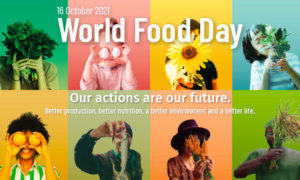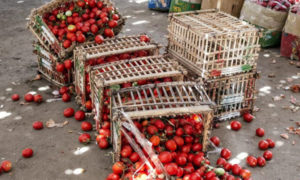Update
World Food Day 2021
16 October is World Food Day. The food we choose and the way we consume it affect our health and that of our planet. It has an impact on the way agri-food systems work; we need to be part of the change.
Future of Food
An agri-food system is a complex term that may seem far from your reality, but do you know our lives depend on them? Every time we eat, we participate in the system. The food we choose and the way we produce, prepare, cook and store it make us an integral and active part of the way in which an agri-food system works.
A sustainable agri-food system is one in which a variety of sufficient, nutritious and safe foods is available at an affordable price to everyone, and nobody is hungry or suffers from any form of malnutrition. The shelves are stocked at the local market or food store, but less food is wasted and the food supply chain is more resilient to shocks such as extreme weather, price spikes or pandemics, all while limiting, rather than worsening, environmental degradation or climate change. In fact, sustainable agri-food systems deliver food security and nutrition for all, without compromising the economic, social and environmental bases, for generations to come. They lead to better production, better nutrition, a better environment and a better life for all.
Agri-food systems employ 1 billion people worldwide, more than any other economic sector. Moreover, the way we produce, consume and, sadly, waste food exacts a heavy toll on our planet, putting unnecessary pressure on natural resources, the environment and climate. Food production too often degrades or destroys natural habitats and contributes to species extinction. Such inefficiency, is costing us trillions of dollars, but, most importantly, today’s agri-food systems are exposing profound inequalities and injustices in our global society. Three billion people cannot afford healthy diets, while overweight and obesity continue to increase worldwide.
The COVID-19 pandemic has underlined that an urgent change of route is needed. It has made it even harder for farmers – already grappling with climate variability and extremes – to sell their harvests, while rising poverty is pushing an increased number of city residents to use food banks, and millions of people require emergency food aid. We need sustainable agri-food systems that are capable of nourishing 10 billion people by 2050.
World Food Day
16 October is World Food Day. Collective action across 150 countries is what makes World Food Day one of the most celebrated days of the UN calendar. Hundreds of events and outreach activities bring together governments, businesses, NGOs, the media, and the general public. They promote worldwide awareness and action for those who suffer from hunger and for the need to ensure healthy diets for all.
#WorldFoodDay 2021 will be marked a second time while countries around the world deal with the widespread effects of the global Covid-19 pandemic. It’s a time to look into the future we need to build together.
Food and the Environment
According to the Food and Agriculture Organization of the United Nations (FAO), the global volume of food wastage is estimated at 1.6 billion tons of “primary product equivalents.” Total food wastage for the edible part of this amounts to 1.3 billion tons. This has an impact on the environment:
- Food wastage’s carbon footprint is estimated at 3.3 billion tons of CO2 equivalent of GHG released into the atmosphere per year.
- The total volume of water used each year to produce food that is lost or wasted (250km3) is equivalent to the annual flow of Russia’s Volga River, or three times the volume of Lake Geneva.
- Similarly, 1.4 billion hectares of land (28% of the world’s agricultural area) is used annually to produce food that is lost or wasted.
- Agriculture is also responsible for a majority of threats to at-risk plant and animal species tracked by the International Union for Conservation of Nature (IUCN).
- A low percentage of all food wastage is composted. Much of it ends up in landfills and represents a large part of municipal solid waste. Methane emissions from landfills also represent one of the largest sources of GHG emissions from the waste sector.
The later food is wasted along the chain, the greater its environmental impact because we have to take into consideration the energy and natural resources expended in processing, transporting, storing and cooking food. Food waste that ends up in landfills produces a large amount of methane – a more powerful greenhouse gas than even CO2. For the uninitiated, excess amounts of greenhouse gases such as methane, CO2 and chloroflurocarbons absorb infrared radiation and heat up the earth’s atmosphere, causing global warming and climate change.
With agriculture accounting for 70% of the water used throughout the world, food waste also represents a great waste of freshwater and ground water resources. It is said that a volume of water roughly three times the volume of Lake Geneva is used just to produce food that is not eaten. By throwing out one kilogram of beef, you are essentially wasting 50,000 liters of water that were used to produce that meat. In the same way, nearly 1,000 liters of water are wasted when you pour one glass of milk down the drain.
If you look at land usage, around 1.4 billion hectares of land, roughly a third the world’s total agricultural land area, is used to grow food that is wasted. Millions of gallons of oil are also wasted every year to produce food that is not eaten. All these do not even take into account the negative impacts on biodiversity due to activities like monocropping and converting wild lands into agricultural areas.
In “Enhancing Nationally Determined Contributions (NDCs) for Food Systems” it indicates that all the elements and activities that relate to the production, processing, distribution, preparation and consumption of food account for up to 37% of all greenhouse gas emissions; continuing on a business-as-usual trajectory will single-handedly exhaust the 1.5°C compatible emissions budgets for all sectors. Although 89% of NDCs mention agriculture production, agriculture emissions reduction targets are mainly included in wider land-use targets. More notably, other actions in the food system, such as reducing food loss and waste, or shifting to more sustainable diets, are widely ignored, despite presenting the combined opportunity to reduce emissions by as much as 12.5 Gt CO2e – the equivalent of taking 2.7 billion cars off the road.
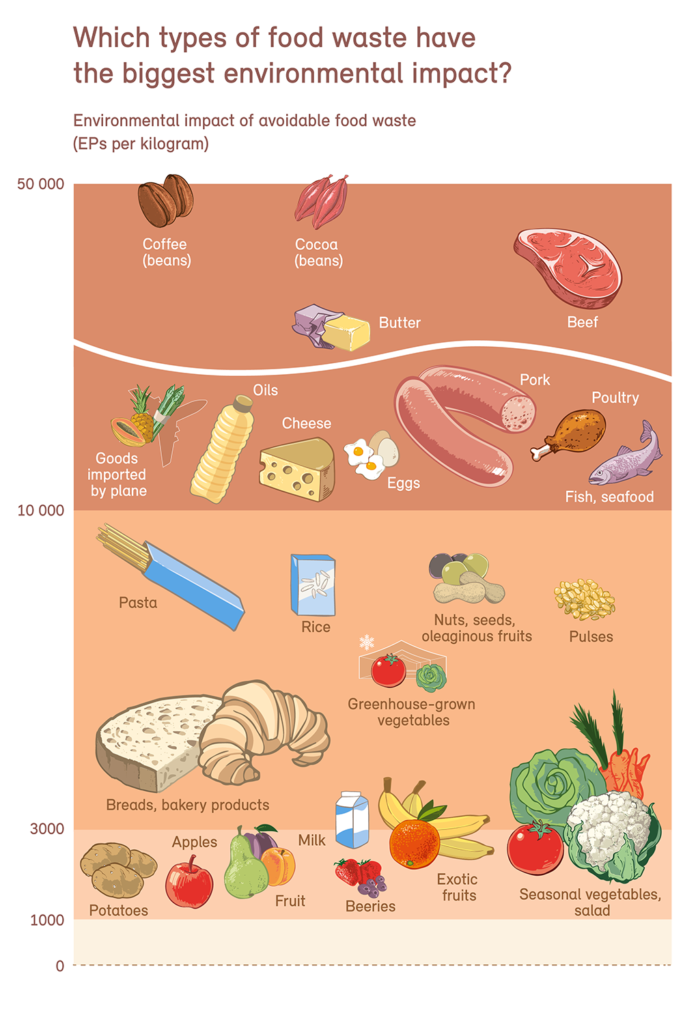
Environmental impact in eco-points (EPs) per kilogram of avoidable food waste in households and the catering industry. The higher up the chart the category is, the greater the environmental impact per kilogram. Reusing food waste may mean that less animal feed, compost, etc. has to be produced. The environmental benefits of these savings have been taken into account in the calculation and in the chart. Image from the Swiss Federal Office for the Environment (FOEN).
Food Loss and Waste
Around 14% of food produced is lost between harvest and retail worldwide, according to FAO. Significant quantities are also wasted in retail and at the consumption level. The United Nations Environment Programme (UNEP) indicates that the world already produces enough food to feed everyone on the planet and in the recent Food Waste Index Report 2021, over 17% of food in total is wasted.
About 38% of total energy consumption in the global food system is also utilized to produce food that is either lost or wasted. In addition, it takes seeds, soil and the labor of farmers to produce food, not to mention the fuel that is needed to transport it. All of these resources are lost when food is wasted.
Furthermore, the disposal of food loss and waste in landfills leads to greenhouse gas emissions, contributing to climate change. Policymakers can improve the chances of achieving climate goals and limiting global warming to 1.5°C by making more specific commitments to transforming national food systems.
International Database
The Food Loss and Waste Database is the largest online collection of data on both food loss and food waste and causes reported throughout the literature. The database contains information from openly accessible reports and studies measuring food loss and waste across food products, stages of the value chain, and geographical areas. In October 2019, more than 480 publications and reports, which have produced more than 20,000 data points, were included. Data can be queried, downloaded, and plotted in an interactive and structured way. The database can be used by anyone who wishes to know more about food losses and waste.
Food and the SDGs
Reducing food losses and waste is critical to achieving the UN Sustainable Development Goals (SDGs). Specifically, SDG 12 aims to ensure sustainable consumption and production patterns, which contains a wide range of targets related to food waste.
SDG Target 12.3
By 2030, halve per capita global food waste at the retail and consumer levels and reduce food losses along production and supply chains, including post-harvest losses. In order to measure food waste and losses, two indices have been proposed:
Sub-Indicator 12.3.1.a – Food Loss Index
The Food Loss Index (FLI) focuses on food losses that occur from production up to (and not including) the retail level. It measures the changes in percentage losses for a basket of 10 main commodities by country in comparison with a base period. The FLI will contribute to measure progress towards SDG Target 12.3.
Sub-Indicator 12.3.1.b – Food Waste Index
A proposal for measuring Food Waste, which comprises the retail and consumption levels is under development. UNEP is taking the lead on this sub-indicator.
Actions
Actions are required globally and locally to maximize the use of the food we produce. The introduction of technologies, innovative solutions (including e-commerce platforms for marketing, retractable mobile food processing systems), new ways of working and good practices to manage food quality and reduce food loss and waste are key to implementing change.
To stop food waste, changes have to be brought in at every stage of the process – from farmers and food processors to supermarkets and individual customers. As a first step, priority should be given to balancing production with demand. This essentially translates to lesser use of natural resources to produce food which is not needed.
More efforts should also go into developing better food harvesting, storing, processing and distributing processes. If oversupply happens, steps should be taken to redistribute the food or to divert it to people who are in need. Additionally, the different actors can reduce their “food footprint” by identifying where waste occurs and taking steps to tackle the same. Fruits which are misshaped or “ugly” are not necessarily bad and can still be bought and used in dishes like soups.
Consumers should also try to buy food in accordance with a meal plan so that they don’t end up wasting edible food. Food may be cheaper when you purchase in bulk, but in reality, you are not really saving money when all you are doing is chucking it in the bin at the end of the week.
If the food still ends up unfit for human consumption, it can be used for feeding livestock, saving precious resources that would have otherwise been used for producing commercial feed. If the food cannot be reused at all, then we should at least try to recycle it in a responsible manner instead of sending it to the landfills where it continues to rot.
Nature-based Solutions (NbS)
Food production has a massive impact on our planet. Moreover, looking forward, global food production needs are expected to increase more than 40% by 2030 and 70% by 2050, compared to average 2005-07 levels, according to OECD and FAO. With more than half of Earth’s habitable lands currently used for agriculture, farmers and food producers play an important role in maintaining and conserving biodiversity. The loss of healthy soils reduces agricultural yields and could result in a food production shortfall of 25% by 2050. In addition, according to the International Union for Conservation of Nature (IUCN), it is estimated that increasing soil biodiversity could contribute up to 2.3 billion tons of additional crop production per year, valued at USD 1.4 trillion.
Leading experts at the Nature-based Solutions and Food Dialogue conducted by the Geneva Environment Network and IUCN discussed why NbS represent a key pathway for achieving this goal while contributing to established international and global targets. Adopting NbS approaches to better our food systems is essential to meeting the fundamental human right to food and contribute to multiple imperatives of the 2030 Sustainable Development Agenda.
According to UNEP, the world already produces enough food to feed everyone on the planet. As the recent Food Waste Index Report 2021 indicated, over 17% of food is wasted. Food waste accounts for up to 10% of global greenhouse gas emissions. It can occur at the consumer end, where food is thrown away, or as post-harvest loss – in storage, transport, packaging, or other stages before food reaches the table. UNEP found that the global average of 74 kg per capita of food wasted each year is similar from lower-middle-income to high-income countries, which means that most countries have room to improve.
Dietary habits represent another intervention area. Over the past 50 years, diets have become increasingly homogenous, dominated by crops that are rich in energy but poor in macronutrients. Of the thousands of plants and animals used for food in the past, less than 200 currently contribute to global food supplies and just nine crops account for almost 70% of all crop production. In many cases –particularly in developing countries – people do not receive the full range of nutrients essential to human health. In fact, low dietary diversity has surpassed caloric insufficiency as the primary driver of death.
Reducing food waste and shifting dietary patterns could reduce anthropogenic greenhouse gas emissions from the food system by as much as 50%. In addition, restoring biodiversity could strengthen the resilience of food systems, enabling farmers to diversify production and cope with pests, diseases and climate change.
Planet-Based Diet
According to WWF, eating a planet-based diet is high in human health benefits and low in environmental impacts. Adopting a planet-based diet can reduce:
- Food-based greenhouse gas emissions by at least 30%
- Wildlife loss by up to 46%
- Agricultural land-use by at least 41%
- Premature deaths by at least 20%
Food Hero
No matter our age, we can be a food hero! Learn about the actions to become a food hero, from eating more fruits and vegetables to reducing food waste, buying locally grown food or even growing our own food at home.
Our choices and actions can make a difference and in the World Food Day Activity Book, we can also follow the journey of food from the farm to our table and the great efforts food heroes make to get it there, no matter the circumstances.
Food Systems
The term “food system” refers to the constellation of activities involved in producing, processing, transporting and consuming food. Food systems touch every aspect of human existence. The health of our food systems profoundly affects the health of our bodies, as well as the health of our environment, our economies and our cultures. When they function well, food systems have the power to bring us together as families, communities and nations.
But too many of the world’s food systems are fragile, unexamined and vulnerable to collapse, as millions of people around the globe have experienced first-hand during the COVID-19 crisis. When our food systems fail, the resulting disorder threatens our education, health and economy, as well as human rights, peace and security. As in so many cases, those who are already poor or marginalized are the most vulnerable.
The good news is that we know what we need to do to get back on track. Scientists agree that transforming our food systems is among the most powerful ways to change course and make progress towards all 17 Sustainable Development Goals. Rebuilding the food systems of the world will also enable us to answer the UN Secretary-General’s call to “build back better” from COVID-19. We are all part of the food system, and so we all must come together to bring about the transformation that the world needs.

Source: International Resource Panel
Role of Geneva
Organizations are listed in alphabetical order
International Geneva
Food and Agriculture Organization of the United Nations (FAO)
FAO has a liaison office in Geneva and FAO’s work on measurement and support to countries to take action to reduce food loss and waste is critical to tracking progress made by countries. In addition, efforts by FAO and UNEP are currently underway to measure progress toward achieving SDG 12.3 through two separate indices – the Food Loss Index (FLI), led by FAO; and the Food Waste Index (FWI), led by UNEP.
Global Alliance for Improved Nutrition (GAIN)
Headquartered in Geneva, GAIN is a Swiss-based foundation that works closely with governments, businesses and civil society to tackle global malnutrition and to transform food systems to provide everyone better access to nutritious, safe and affordable food. Ahead of the Food Systems Summit, GAIN has launched a partnership with the World Wildlife Foundation to deepen thinking on food systems transformation and to accelerate adoption of new solutions, all while leading the Summit’s Action Track.
International Institute for Sustainable Development (IISD)
Aiming to provide a world where people and the planet thrive work, the work of IISD focuses on accelerate solutions for a stable climate, sustainable resources, and fair economies. Recognizing the complexity of today’s challenges, they work on sustainable solutions on various fields such as food and agriculture, nature-based solutions, and climate change.
In the run up to the Food Systems Summit, the IISD has been providing companies, investment funds, and philanthropies new evidence that show how their concrete investment can end world hunger. They are also taking a look at the intersection of food systems, climate change and nutrition, to provide policymakers pathways that address these issues together.
International Standard Organization (ISO)
ISO has more than 1,600 standards related to the food sector, with many more in development. The world population is growing rapidly and many food products repeatedly cross national boundaries to meet our rising demand for food. International Standards help to address this challenge in a safe and sustainable way, through guidance and best practice in food production methods and testing, to promote safety, quality and efficiency across the entire food industry.
International Trade Centre (ITC)
The work of ITC on Food and Agri-Business build sustainable agricultural exports and strengthen intraregional trade by assisting farmers, communities and agri-food enterprises while ensuring sustainability.
International Union for Conservation of Nature (IUCN)
The work of IUCN on Nature-based solutions (NBS) and Sustainable Land Management provide an array of approaches for sustaining food production while safeguarding the ecosystem services upon which agriculture depends.
United Nations Conference on Trade and Development (UNCTAD)
UNCTAD is active in responsible consumption and production and it’s BioTrade Initiative looks at products or services that sourced from biodiversity is commercialized and traded in a way that respects people and nature. The BioTrade Principles and Criteria (P&C) is a set of guidelines for businesses, governments and civil society wishing to support the conservation and sustainable use of biodiversity, as well as the fair and equitable sharing of benefits through trade.
United Nations Economic Commission for Europe (UNECE)
UNECE has addressed the food loss challenge since 2013 – including in view of enhancing the circular economy in its member states. Through the constant review of its quality standards for agricultural produce traded internationally and nationally, UNECE ensures that the quality of the produce used and traded is maintained along the entire supply chain. Food loss is therefore prevented and reduced. UNECE also focuses on the food lost in the trade process before it reaches the consumer and even retail.
United Nations Environment Programme (UNEP) Offices in Geneva
UNEP and partner organization WRAP recently published the Food Waste Index Report 2021. It looks at food waste that occurs in retail outlets, restaurants and homes – counting both food and inedible parts like bones and shells. The report presents the most comprehensive food waste data collection, analysis and modelling to date, and offers a methodology for countries to measure food waste. 152 food waste data points were identified in 54 countries.
Think.Eat.Save is a partnership between UNEP and FAO contributing to the Sustainable Food Systems Programme of the 10 Year Framework of Programmes on Sustainable Consumption and Production (10YFP), also known as the One Planet Network.
United Nations Human Rights (UNHCR)
The Special Rapporteur on the Right to Food addresses the need for an integrated and coordinated approach to promoting and protecting people’s right to food, for example, climate change and the right to food. It outlines the adverse impact of climate change on the right to food and places particular emphasis on the geographic and socioeconomic vulnerabilities of those most affected. It also highlights the negative impact that current agricultural practices and food systems are having on climate change. The current Special Rapporteur on the Right to Food is Michael Fakhri.
World Business Council for Sustainable Development (WBCSD)
WBCSD Food and Nature Program leads business efforts to accelerate the much-needed system transformation in the areas of food, nature and water. We do this by bringing leadership standards and tools, advocacy and projects across the value chain – from production to consumption – which deliver impact at scale where the urgent agendas of climate, nature and food systems intersect. The program also tackles food and agriculture and its Guide to Food System Transformation identified seven pathways where business must lead to drive system transformation and ensure delivery of the SDGs and the Paris Climate Agreement. We address climate resilience and mitigation, nature and biodiversity loss, livelihoods and human rights, and nutrition and health.
World Economic Forum (WEF)
Among the global issues covered by WEF is the “Future of Food” proving strategic analysis, trends and research on the topic.
World Food Programme (WFP) Office in Geneva
WFP work on sustainable livelihoods and ecosystems helps countries and the most vulnerable and food insecure communities manage natural resources sustainably such as soil conservation and fertility measures; water harvesting and flood control; agro-ecological productivity to reduce biodiversity loss; irrigation schemes; forestry and agroforestry management; and, access to clean water in arid and semi-arid contexts results in more diversified food, thereby complementing nutrition efforts. The restoration of degraded ecosystems boosts public health and reduces hardship in general.
WWF International
WWF works on projects that improve efficiency and productivity in food systems while reducing waste and shifting consumption patterns. WWF also builds public awareness on how we consider food.
Switzerland and Local Geneva
In Switzerland, the average annual food waste form farm to fork is of about 300 kg per capita (2,564,500 tonnes in 2019 according to Swiss Federal Office for the Environment, of which 90 kg per capita at the households level.
Biovision
The CLEVER activity created by the Biovision makes it possible to address the theme of responsible consumption with the public, especially young people.
Canton and City of Geneva
The Canton of Geneva imports approximately 80% of the commodities consumed by its population. The transport of food products is the third-largest flow of resources consumed in Geneva after building materials and energy products. The Canton de Genève provides resources on food waste and the City of Geneva lists tools on learning how to adopt to a local and sustainable approach to eating.
Fédération Romande des Consommateurs (FRC)
FRC provides tools for consummers to avoid food waste.
Partage
Partage is a food bank created in 2005 by the Salvation Army, C.A.R.E., Caritas Genève, les Colis du Cœur and Emmaüs. It salvages food waste and provides them to different beneficiaries.
Swiss Federal Office for the Environment
The Swiss Federal Office for the Environment provides information on food waste in Switzerland. About 25% of the country’s nutrition-related environmental impact is caused by avoidable food waste. In 2013, the Swiss Federal Council adopted measures to reduce food waste as part of the Green Economy Action Plan. Among others, it has resulted in a stakeholder dialogue and the implementation of a number of initial actions. With the adoption of the Chevalley postulate (18.3829) on 5 March 2019, the National Council mandated the Federal Council to produce an action plan on food waste prevention.
WWF Switzerland
The Swiss organization of WWF provides resources and an app on food waste.
Zero Waste Geneva
Zero Waste Geneva is a community for those looking to reduce waste, preserve natural resources and create a more sustainable future! The organization offers workshops and resources on reducing food waste.
Events
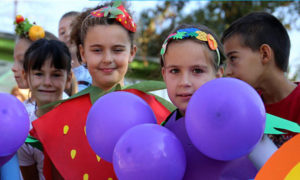
Global World Food Day Ceremony
15 October 2021 | 11:00 CEST | Online | FAO

Le Mois du Goût Genève
Until 16 October 2021 | City of Geneva
Learning
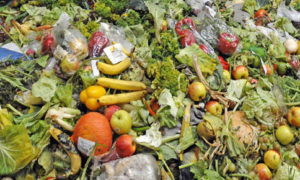
Food Loss Analysis E-Learning Course
Online | FAO

Quiz Gaspillage Alimentaire
Online | Fédération Romande des Consommateurs
Resources
Articles
- Around 35% of UK’s greenhouse gas emissions from food and drink | The Caterer | 6 October 2021
- Turning food waste into food | Ekathimerini | 4 October 2021
- Global review looks to reverse current performance of food system | IISD | 28 September 2021
- UN report calls for repurposing of USD 470 billion of agricultural support that distorts prices and steer us away from environment and social goals | FAO, UNDP, UNEP | 14 September 2021
- Most agricultural funding distorts prices, harms environment: UN report | UN News | 14 September 2021
- 12 apps preventing household food waste and protecting the planet | Foodtank | September 2021
- World leaders and experts call for significant reduction in the use of antimicrobial drugs in global food systems | WHO | 24 August 2021
- Food systems hold key to ending world hunger | UNEP | 14 July 2021
- UN Report: Pandemic Year Marked by Spike in World Hunger | WHO | 12 July 2021
- Scientists Reject Proposed “IPCC for Food” | Geneva Solutions | 12 July 2021
- Whose Seeds Are They Anyway? Peasants’ Call for Common Ownership | Geneva Solutions | 9 July 2021
- Climate Change Threatens Age-Old Indigenous Food Systems, Says UN | WEF | 30 June 2021
- Five Ways We Can Reduce Food Emissions to Keep Global Temperatures Down | WEF | 23 June 2021
- Trade and Food Security: When an Agreement Delayed Becomes a Human Right Denied | UNCTAD | 7 June 2021
- Rethinking Food Systems | UNEP | 4 June 2021
- Why Trade Must Be Part of the Solution to Biodiversity Loss | UNCTAD | 21 May 2021
- EU and FAO Call for the Transformation of Agri-Food Systems | Scaling Up Nutrition | 10 May 2021
- Nature-based Solutions Can Save the Planet, But Only If We Change Our Diets Too | WEF | 12 March 2021
- Wasting food just feeds climate change, new UN environment report warns | UNEP | 4 March 2021
- Serving Up Sustainable Food | UNEP | 20 January 2021
- Green Technology for Food and Agriculture | WIPO | 16 October 2020
- Food Lost and Wasted: The Invisible Face of Our Food Chain and an Opportunity for Change | UNECE | 29 September 2020
- Transformation of Our Food Systems – Making of a Paradigm Shift | Hans R. Herren, Benedikt Haerlin and the IAASTD+10 Advisory Group | 28 September 2020
- Why sustainable food systems are needed in a post-COVID world | UNEP | 14 July 2020
- Hungry for Change: The Global Food System | UNEP | 18 June 2020
GEN Activities
- Nature-based solutions and food | Geneva Nature-based Solutions Dialogues | 13 September 2021
- Wednesdays for the Planet: Organic Food – Hype or Hope? | Geneva Environment Network | 9 June 2021
- Wednesdays for the Planet: The Fish on My Plate | Geneva Environment Network | 19 May 2021
- Wednesdays for the Planet: Sustainable Food for a Sustainable Future | Geneva Environment Network | 5 May 2021
- World Environment Day 2013 Geneva | Think.Eat.Save
Podcasts
- This is How Farming Shrimp Can Restore Our Coastlines and Create Jobs | WEF | 9 June 2021
- Food Waste, Food Loss and the Role of Packaging | WBCSD
Reports
- A multi-billion-dollar opportunity: Repurposing agricultural support to transform food systems | FAO, UNDP and UNEP | 14 September 2021
- Food waste index report 2021 | UNEP | 4 March 2021
- The state of food security and nutrition in the world 2021 | FAO, IFAD, UNICEF, WFP and WHO | 2021
- Transformation of our food systems – the making of a paradigm shift | Hans R. Herren, Benedikt Haerlin and the IAASTD+10 Advisory Group | 28 September 2020
- Enhancing Nationally Determined Contributions (NDCs) for food systems | Climate Focus, EAT, UNEP and WWF | 2020
- Healthy diets from sustainable food systems | EAT-Lancet Commission | 2020
- Mitigating risks to food systems during COVID-19 | FAO | 2020
- What a waste 2.0 | World Bank | 2018
- Food wasted footprint: Impact on natural resources | FAO | 2013

